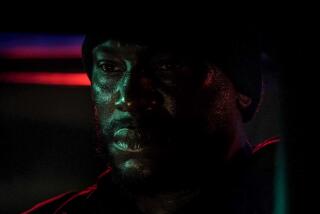Cool is the fuel
Miami
“Did you know the guy who invented the hokey-pokey died the other day?” asks Tyrese, a suspiciously grave look on his handsome face. It’s late in the day here on the set of “The Fast and the Furious 2,” but as director John Singleton prepares to shoot a scene with Tyrese and co-star Paul Walker, it’s clear that the hip-hop crooner-turned-actor is just warming up.
For the record:
12:00 a.m. Dec. 12, 2002 For The Record
Los Angeles Times Thursday December 12, 2002 Home Edition Main News Part A Page 2 National Desk 10 inches; 366 words Type of Material: Correction
Tyrese -- A headline in Tuesday’s Calendar that accompanied an article about “The Fast and the Furious 2” incorrectly called the film’s star Tyrese a rap star. Tyrese is a singer with hip-hop influences.
“It was really sad at the funeral,” he continues. “They were trying to get him into the casket and his right foot was in, but his left foot was out. And then his left arm was in, but his right arm was out.” Tyrese begins to do a little soft-shoe as he breaks into song. “And you do the hokey-pokey.”
“It’s 4:15 and Tyrese is awake,” first assistant director Bruce Franklin dryly announces. Singleton chimes in: “ ‘Rese is on set. Let’s roll!”
It was pretty much at this moment that I felt Universal Pictures could stop worrying about the most pivotal question facing the makers of the sequel to “The Fast and the Furious”: Was the studio crazy when it told Vin Diesel to take a hike when he asked for $20 million to reprise his streetwise tough-guy role from the original film? After all, it was Diesel, Walker’s original co-star, who catapulted to stardom last year in the low-budget, high-velocity street-racing movie that was the surprise hit of 2001, making $145 million in its theatrical run and selling 7 million copies of its video when it hit stores in January.
Diesel may be more of a household name now, but Tyrese, who made his film debut last year in Singleton’s “Baby Boy,” has just as much rippling muscle, more tattoos (nine at last count), a wealth of under-25 fans from his MTV VJ stints and silky hip-hop records, and judging from the crowds of girls who materialize wherever he goes, plenty of sex appeal.
On the set, Tyrese, who’s 23, and Walker, who’s 29, have enough chemistry to launch a small rocket. Before shooting a scene one day, Tyrese impishly mimics Walker’s surfer-dude twang, perfectly enunciating every syllable -- “Oh, hello, what’s up there, brother” -- with Walker coolly responding in his best gang-banger patois: “Hey, cuz, wass up?”
In the film, where the actors play old friends who use their street-racing skills to go undercover and bust a Miami drug kingpin, Tyrese has added his own style of improvised humor. In a scene in which the two both want to drive the same hot car, Tyrese tells Walker: “Don’t even think about taking the convertible. It might loosen your mousse.” As Singleton explains: “I have a lot for respect for Vin, but Vin is like Vin. Tyrese is like a kid from the street. He brings a real flavor and humor to everything. He’s as funny as Eddie Murphy ever was, but mostly, he’s just cool.”
Also starring ...
For all that Diesel, Walker and the souped-up cars brought to the party, the real star of “The Fast and the Furious” was its ineffable sense of cool. “Let’s face it, before they saw the movie, kids didn’t know who Vin or Paul was,” says “F&F2;” producer Neal Moritz, who produced the original, as well as such youth-culture hits as “XXX,” “Cruel Intentions” and “I Know What You Did Last Summer.” “They liked the cars and the lifestyle. The movie did $40 million on its opening weekend for one reason -- it looked cool.”
But as anyone who makes products for fickle teenagers knows, cool is a slippery commodity that melts away just as mysteriously as it materializes. Virtually every decision Universal has made, including taking a pass on Diesel, has revolved around the issue of cool. Letting Diesel go certainly involved economics -- Tyrese is being paid roughly $750,000, a fraction of Diesel’s asking price. But the film’s budget is still twice the original’s $38 million, with $8 million to $10 million alone being spent on an armada of 189 specially designed street racers. Even though Walker was signed to a $2-million sequel option, the actor is getting $7 million, a reward, in part, for not letting his ego get out of joint when Diesel got the lion’s share of credit for the original film’s runaway success.
In today’s sequel-happy Hollywood, there was never any doubt that “The Fast and the Furious,” having spawned a new breed of maverick action heroes, was a franchise in the making. In fact, the studio was so eager to get a sequel going that it had screenwriters working on two scripts simultaneously, one with Diesel’s character, one without him. As negotiations with Diesel wore on, the studio became convinced that it would be impossible for the sequel to have any underdog appeal with a $20-million star in the lead. (Case in point: “Bad Boys 2,” which is paying untold millions in salary and profit participation to Will Smith and Martin Lawrence, has also been shooting in Miami for the past few months, but whenever I asked local kids about the two films, all they wanted to hear about was “F&F2.;”)
When Diesel departed, so did the film’s original director, Rob Cohen, who joined Diesel and Moritz in making “XXX,” which many in Hollywood saw as a de facto “Fast and Furious” sequel. Universal was unperturbed, even when Fox TV hastily put a “F&F;” knockoff called “Fast Lane” on the air this fall. One reason the studio’s confidence remained high was a Teen Research Unlimited survey of teenage moviegoers, which discovered that its respondents’ all-time favorite movie was “The Fast and the Furious,” out-polling both “The Matrix” and “Spider-Man.”
Across ethnic lines
All along, the studio believed that its film’s coolness was rooted in its multiethnic appeal. Although Diesel and co-stars Michelle Rodriguez and Rick Yune have departed, the new cast hits as many cross-cultural chords as possible. According to studio surveys, Latinos made up roughly 40% of the audience for the original film, one reason why Universal chose to set the picture here. So the sequel remains heavily ethnic, with lots of Spanglish slang and Latin humor.
When most filmmakers shoot in Miami, they swarm around Art Deco South Beach; Singleton has been filming his street-racing scenes in Overtown and Little Haiti. As he puts it: “This isn’t going to look like every Joel Silver movie from the ‘80s.” Cuban-born actress Eva Mendes (“Training Day”) plays an undercover agent romancing both Walker and his drug-lord foe, played by Cole Hauser, who first worked with Singleton in “Higher Learning.” Singleton cast Chanel model Devon Aoki as a street racer and hip-hop star Ludacris as a race organizer. The role of the film’s top auto mechanic went to Jin, a Chinese-American hip-hop artist Singleton discovered “doing freestyle rapping, shutting all the brothers down” on a BET music show.
Although Singleton’s recent movies haven’t been as well received as such early films as “Boyz N the Hood” and “Poetic Justice,” the 34-year-old director has a knack for discovering new talent and coaxing good performances out of young actors. Singleton initially wanted to direct another Universal project, a sequel to “Pitch Black,” but after Moritz and Universal Co-President Scott Stuber solicited Singleton’s advice on casting Tyrese in “F&F2;,” they came back with another question: “What about you?”
Singleton acknowledges that he’s a director for hire on this film, which pulses with far more pedal-to-the-metal action than any of his previous films. After virtually every take, he asks his script supervisor how long the scene ran. When a dialogue scene plays for 49 seconds, Singleton jumps into action. “I know you can act, so don’t give me none of those pregnant pauses,” he tells the actors. He turns to me and explains: “Fifteen or 17 seconds is a long time to hold on anything in this picture. You oughta call this my attention-deficit movie.”
Singleton sees “F&F2;” as a “bubble-gum movie” but one that won’t insult the intelligence of its audience. When he spoke to a group of University of Miami film students the other night, someone asked if he’d been criticized for making such an “escapist” film. Singleton: “Nobody can tell me [anything]. I made serious dramas like ‘Boyz,’ ‘Rosewood’ and ‘Higher Learning.’ I have a right to have some fun.” He laughs. “Why should the hack directors get all the good jobs!”
“The Big Picture” runs every Tuesday in Calendar. If you have questions, ideas or criticism, e-mail them to Patrick.Goldstein@latimes .com.
More to Read
Only good movies
Get the Indie Focus newsletter, Mark Olsen's weekly guide to the world of cinema.
You may occasionally receive promotional content from the Los Angeles Times.









